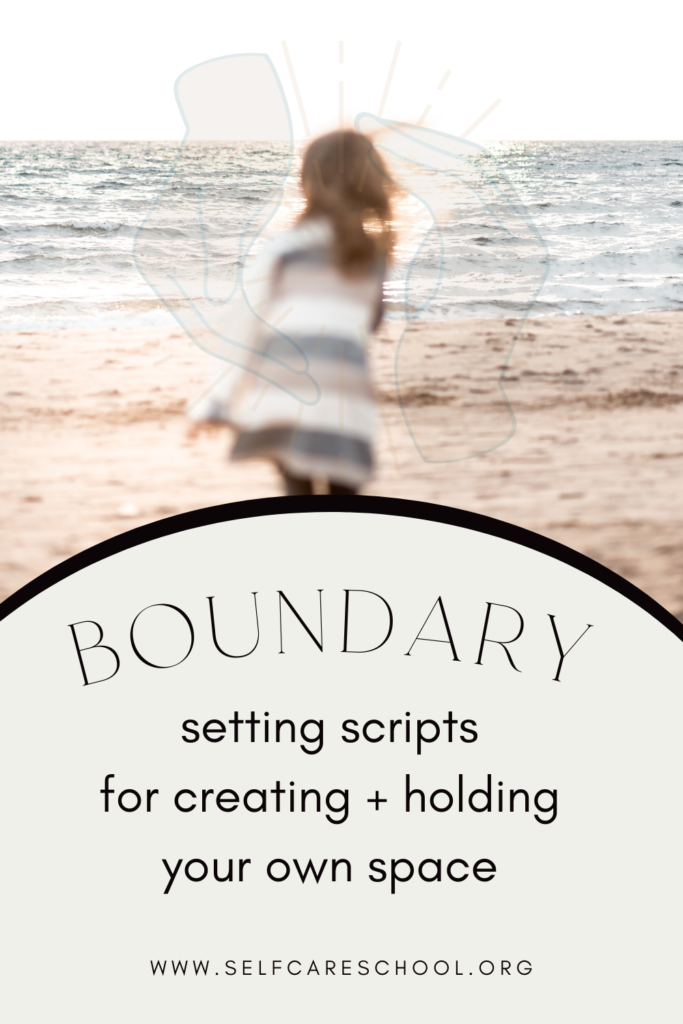How to Create Boundaries
Boundaries are the unseen lines that define our personal space, both mentally and emotionally. They are the guidelines we establish to protect our energy, ensuring that we are not excessively drained, taken advantage of, or overwhelmed by external forces.
This piece will go over how to create boundaries that are right for you and how to communicate boundaries to other people.
Start with Self-Reflection
Begin by taking a journey inward. Ask yourself:
- When do I feel most drained or overwhelmed?
- Are there specific situations or individuals that consistently lead to these feelings?
- What are my emotional and physical cues that indicate I’ve crossed my limits?
Answers to these questions will provide the initial roadmap for where boundaries may be most needed.
Clearly Define Your Boundaries
Boundaries can be both tangible and intangible. Some might relate to your time, such as setting specific hours where you disconnect from work or technology. Others might be emotional, like choosing not to engage in discussions that consistently drain your energy.
Remember, boundaries are personal. They are neither about being rigid nor about isolating oneself but rather about understanding and honoring one’s limits.
Communicate Your Boundaries with Grace
Expressing your boundaries doesn’t mean erecting impenetrable walls. Approach conversations with empathy and clarity. Instead of saying, “I don’t want to discuss this,” try, “I find this topic emotionally draining. Can we talk about something uplifting?” The goal is understanding, not alienation.

Boundary-Setting Scripts
Setting boundaries can be challenging, especially when trying to communicate them clearly and assertively without causing misunderstandings. Here’s a list of scripts to help articulate various types of boundaries in different situations:
Personal Time & Self-Care
“I’ve committed to some personal time this evening. Can we discuss this tomorrow?”
“I’m working on balancing my time better. Let’s set a specific time to chat.”
Work-Life Balance
“I don’t check work emails after 6 PM to maintain work-life balance. I’ll respond during working hours.”
“To ensure productivity, I’m setting specific times for meetings. Does 2 PM work for you?”
Physical Boundaries
“I’m more comfortable with a handshake than a hug.”
“I value my personal space. I hope you understand.”
Emotional & Mental Health
“I need some time alone to process things. Can we talk later?”
“This topic is a bit heavy for me right now. Can we switch to something lighter?”
Relationships & Social Situations
“I need a night off from socializing, even if it’s just online. Let’s catch up another day.”
“It’s important for me to spend quality time with my family on weekends.”
Financial Boundaries
“I’ve set a budget for myself this month and need to stick to it.”
“I’m not comfortable lending money. I hope you can understand.”
Digital & Online Communication
“I’m taking a digital detox this weekend. If it’s urgent, please call.”
“I’ve set my online status to ‘Do Not Disturb’ during focus hours. I’ll get back to you once I’m available.”
Health & Lifestyle Choices
“I’ve chosen a vegetarian lifestyle, and I’d appreciate it if you respect my choice.”
“I’m avoiding alcohol right now. Thanks for understanding.”
Conversations & Discussions
“I’m not comfortable discussing my personal life at work.”
“I’d rather not get into political discussions during family dinners.”
Declining Requests or Invitations
“Thank you for thinking of me, but I won’t be able to commit to this project.”
“I appreciate the invitation, but I have prior commitments on that day.”
Remember, it’s crucial to set boundaries with kindness and clarity. It’s not about being defensive or isolating oneself but ensuring mutual respect and understanding in interactions. These scripts serve as a guide, but personalizing them to fit your specific situation and comfort level is essential.
Regularly Review and Adjust Your Boundaries
Our journey through life is constantly evolving. What may seem like an essential boundary today might change based on life’s transitions. Periodically revisit your boundaries, adjusting as necessary. This ensures that they remain relevant and effective.
The Legacy of Boundaries
By setting and honoring boundaries, we not only elevate our own well-being but also model positive behaviors for those around us. It becomes a generational lesson in self-respect, understanding, and personal space. By nurturing ourselves, we lay the foundation for a future where self-care and mutual respect become inherent values.
Types of Boundaries
There are different types of boundaries. Understanding and setting these boundaries is crucial for maintaining well-being, self-respect, and healthy relationships. Here are some primary types of boundaries:
Physical Boundaries:
- Pertaining to personal space, physical touch, and privacy.
- Examples include preferences in closeness with others (like hugging vs. handshaking), or comfort levels with shared living spaces.
Emotional Boundaries:
- Relate to protecting one’s feelings and ensuring emotional well-being.
- Examples include deciding to whom you open up about personal experiences or guarding against absorbing others’ emotional states.
Intellectual Boundaries:
- Concerning thoughts, ideas, and how they’re respected.
- Examples include being open to debate without feeling attacked or respecting others’ opinions even if they differ from yours.
Time Boundaries:
- Related to how an individual uses their time.
- Examples include setting specific work hours, designating personal time, or creating slots for self-care.
Sexual Boundaries:
- Pertaining to comfort levels and consensual expectations with intimacy.
- Examples include communication of what is acceptable and what isn’t in an intimate relationship.
Material Boundaries:
- Relate to money and possessions.
- Examples include lending items to friends or deciding on shared expenses in relationships.
Digital/Online Boundaries:
- Concerning the online world and digital communication.
- Examples include not checking work emails during personal time, setting privacy settings on social media, or deciding when to share personal information online.
Spiritual Boundaries:
- Pertaining to personal beliefs and practices.
- Examples include the choice to engage in specific religious practices or the respect for individual spiritual beliefs.
Workplace Boundaries:
- Specific to professional environments and relationships.
- Examples include not taking work calls during non-working hours or ensuring a comfortable work environment free from harassment.
Relational or Social Boundaries:
- Concerning the dynamics within various relationships, be it familial, romantic, or platonic.
- Examples include setting limits on time spent with certain acquaintances or communicating deal-breakers in romantic relationships.
While these are general categories of boundaries, it’s essential to understand that everyone’s boundaries are personal and can vary widely. What’s comfortable for one person might not be for another. Regular introspection and clear communication are vital in setting and maintaining healthy boundaries.
In the grand tapestry of life, where generational patterns weave in and out, boundaries are the threads of gold. They shimmer with self-worth, resilience, and respect. In creating them, we don’t just preserve our tapestry; we ensure its brilliance is passed down, undimmed, to the generations that follow. Embrace this journey of boundary-setting as one of the most profound acts of self-care, and in doing so, craft a legacy of well-being.
What Boundaries Look Like
Looks Like This:
- “I appreciate the invite, but tonight’s my personal time. Let’s reschedule!”
- “I value our conversations, but I need a break from this topic right now.”
- “I won’t be checking emails after 6 PM to balance work and personal life.”
Doesn’t Look Like This:
- Overcommitting and then feeling drained or resentful.
- Consistently allowing negative conversations without voicing discomfort.
- Responding to work issues round-the-clock without setting hours of unavailability.
Boundaries vs. Rules: Navigating Personal and Collective Guidelines
Boundaries and rules, while sometimes used interchangeably, serve distinct purposes in our interactions and relationships. Understanding the nuanced differences between these two can empower us to foster healthier, more harmonious connections with ourselves and others.
Boundaries: The Personal Protector
- Origin: Boundaries are deeply personal and arise from an individual’s needs, experiences, and values. They stem from self-awareness and introspection.
- Purpose: Boundaries serve to protect an individual’s emotional, mental, and physical well-being. They delineate what is acceptable and what isn’t for an individual.
- Flexibility: While some boundaries may be firm, they can often be flexible, evolving based on one’s growth, experiences, and changing circumstances.
- Communication: Boundaries can be silently held or overtly communicated. Expressing them often requires vulnerability, as one needs to articulate personal needs and limits.
- Examples: “I need some alone time to recharge,” “I prefer not to discuss my weight,” or “I’m not comfortable lending money.”
Rules: The Collective Framework
- Origin: Rules are typically established by a group, community, or institution to provide a structured framework for behavior. They are external standards set to manage and guide group dynamics.
- Purpose: Rules aim to create a harmonious, predictable, and often safe environment for everyone within a particular group or setting.
- Flexibility: Rules tend to be more rigid than boundaries. They are set standards, and deviations might lead to consequences or penalties.
- Communication: Rules are typically overt, written, or stated explicitly, ensuring everyone in the group is aware and can adhere to them.
- Examples: “No cell phones in the meeting,” “Library books must be returned within two weeks,” or “No smoking in this area.”
In Essence:
While both boundaries and rules help shape interactions and relationships, they differ in origin, purpose, and flexibility. Boundaries are deeply personal shields, safeguarding an individual’s well-being. In contrast, rules are collective agreements, ensuring group cohesion and harmony. Recognizing and respecting both is pivotal in fostering meaningful, healthy connections.






